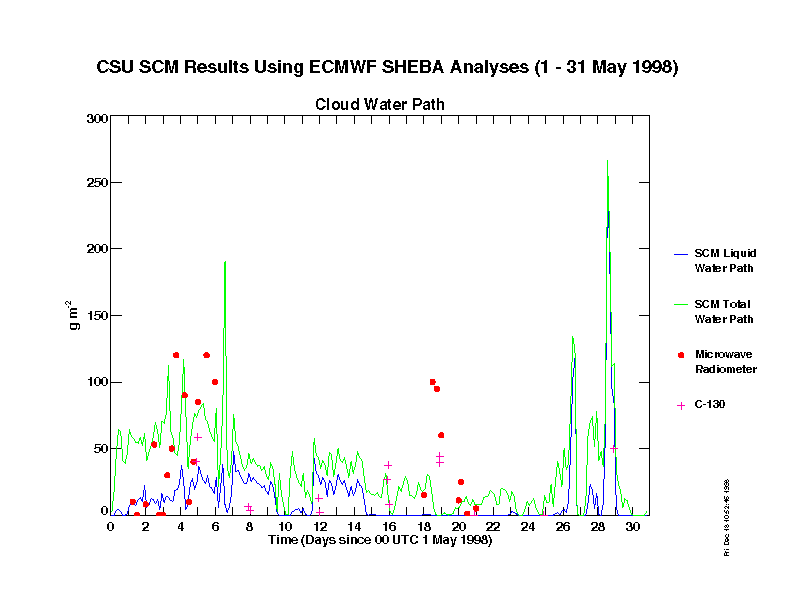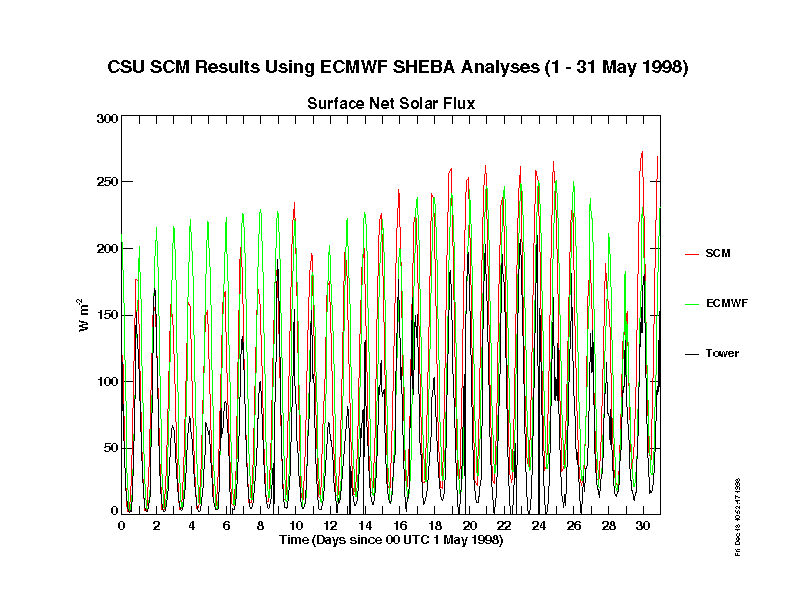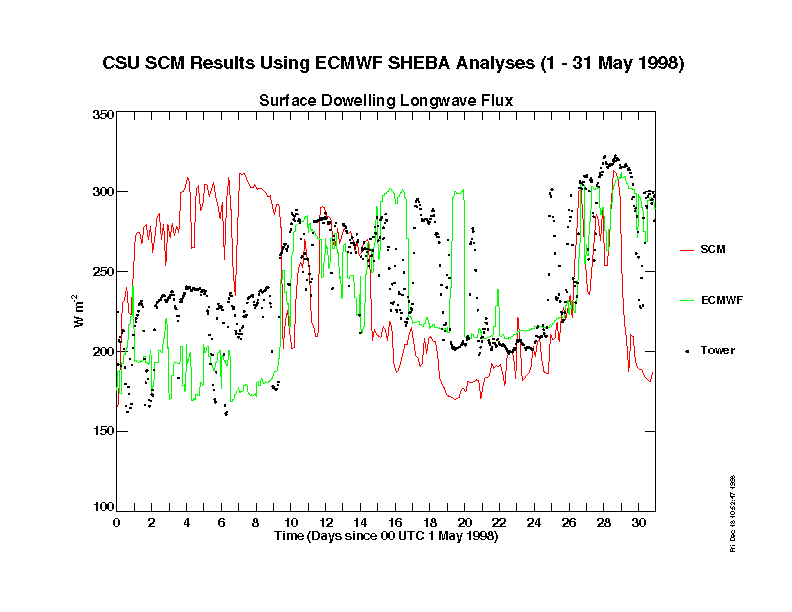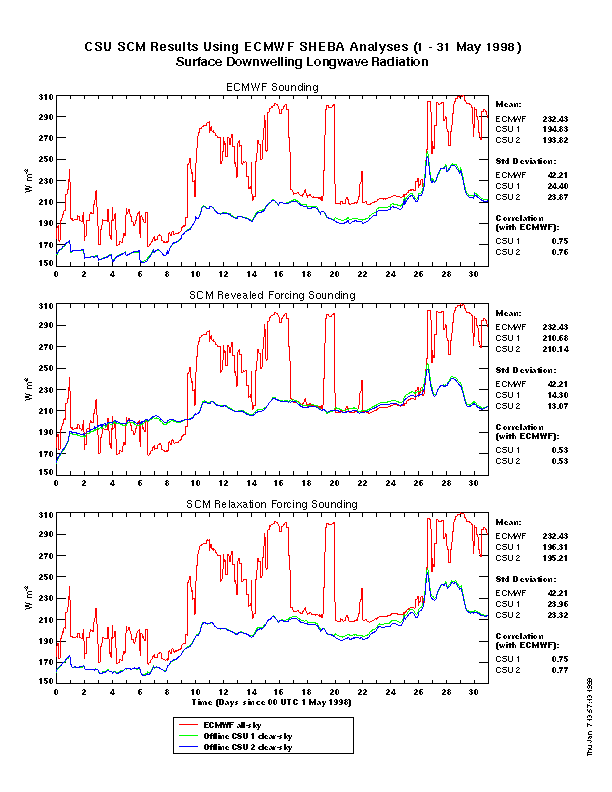Simulation
of Arctic Weather with a Single-Column Model
Douglas G. Cripe, Cara-Lyn
Lappen, Phil Partain, and David A. Randall
Department of Atmospheric
Science, Colorado State University
I Introduction
Among
the various climate regimes of Earth the Arctic presents particular challenges.
Complex feedback mechanisms of the ocean-ice-atmosphere system, in conjunction
with the paucity of observational data, pose modeling difficulties not
encountered elsewhere on the planet (Randall et al.,1998) In this study,
we explore some of these issues by simulation of the Arctic environment
with the Colorado State University (CSU) Single-Column Model (SCM), which
is then compared with observational data gathered at the Surface Heat Budget
of the Arctic (SHEBA; Moritz et al. 1993) field project. Within the context
of SHEBA, observational data were provided by both the Atmospheric Radiation
Measurement (ARM; DOE, 1996) program, and the First ISCCP Regional Experiment
(FIRE; Randall et al. 1995; ISCCP is the International Satellite Cloud
Climatology Program).
II Model and Forcing
The
SCM, as the name implies, is a single grid column extracted from the CSU
General Circulation Model (GCM). It has 17 layers, using generalized sigma
coordinates, and the complete GCM physics package. Since it is a single
grid column, however, there is no communication with adjacent grid cells
and thus the SCM must be "driven" with observational data that includes
dynamical fields such as advective tendencies of temperature and moisture.
Observational data of this caliber is not yet available from the Arctic,
so the fields of total advective tendency and surface fluxes necessary
to drive the SCM were obtained from analyses generated at the European
Center for Medium-Range Forecasting (ECMWF), corresponding to the location
of the SHEBA site. Twice-daily soundings and routine surface observations
of pressure, wind, temperature and humidity taken from the ice camp were
assimilated into the ECMWF model during each analysis cycle. The data represent
a model grid column approximately 60 km wide in proximity to the SHEBA
ice camp, and the column position was frequently updated to account for
camp drift.
We have chosen
to model the month of May, 1998, with our SCM since considerable observational
data from SHEBA are now available for this period in collaboration with
instrumentation provided by ARM and FIRE. A brief weather summary for the
month based on observations taken at the ice camp is shown in Table 1 below.
May 1998 SHEBA Ship Weather Overview
| Sunday |
Monday |
Tuesday |
Wednesday |
Thursday |
Friday |
Saturday |
| |
|
|
|
|
1
low NW
winds W-SW
overcast
light snow |
2 |
3
|
4
St, As, Ci
light snow |
5 |
6 |
7
thin PBL St |
8
high moving N
winds E
clouds incr
snow |
9 |
10
|
11
low moving N
winds SW
St, As, Ci
snow |
12 |
13 |
14
snow ends |
15
High N; low S
winds E
PBL St thins |
16 |
17
|
18
PBL St, thin Ci |
19
thin PBL St, Ci |
20
clear |
21
thin PBL St, Ci
|
22
thin St |
23
some As, Ci |
24
clear
|
25
clouds incr |
26 |
27
overcast |
28
low moving N
winds S-SW
As, Ci
drizzle |
29
temps > 0
St, Ci
rain |
30
PBL St, As |
Table 1. Weather was mainly overcast
with light snow each day from 1-14 May; clouds were then variable for remainder
of month with clear skies reported on 20 and 24 May; clouds increased 28-30
May with liquid precipitation reported for first time that year.
III Results
For
all results presented here, total advective tendency forcing was used to
drive the SCM. Figure 1 shows a time-height (pressure) time series of the
moisture (left side) and temperature (right side) profiles. The top panel
in each case shows the ECMWF analysis for the period, the middle panels
present the SCM output, and the bottom panels are difference plots between
the SCM and the ECMWF profiles. Focussing first on the temperature series,
we see that the general features represented in the ECMWF analysis are
also captured in the SCM output, notably the three instances of warming
that occurred from days 10-12, 16-18, and 22-29. The trends in the upper
troposphere above 400 mb are also in general agreement between the two
models. However, inspection of the difference plot reveals a couple of
marked discrepancies. In particular, the SCM tends to be warmer than the
ECMWF in the lower troposphere below 400 mb by as much as 13 K in the first
10 days of the period. By contrast, between days 26-28 the SCM is colder
than the ECMWF analysis by 7 K from 900 to 800 mb. Moreover, the SCM shows
a cold bias in the upper troposphere above 300 mb throughout the entire
period.

Figure 1. Time-height (pressure) plot showing time series sounding
profiles of water vapor mixing ratio (left) and temperature (right). ECMWF
analyses are top panels, SCM output are middle panels, and difference plots
are bottom panels.
On
the left side of Figure 1, we note that, as with the temperature plots,
the general features of the water vapor mixing ratio profiles are discernible
in both the ECMWF analysis and the SCM output. In particular, there is
agreement on episodes of moistening and drying that occurred between days
10-12, 14-18, and especially 26-29. Once again, however, the difference
plot reveals that there was less than complete harmony: in the first 10
days of the run the SCM is considerably more moist than the ECMWF analysis,
from the surface up to 800 mb. This period corresponds to the warm bias
that the SCM exhibited in the temperature profile. Similarly, towards the
end of the period when the SCM showed a cold bias in the temperature profile,
it also produced a dry bias compared to the ECMWF analysis. Generally,
the SCM moisture appears to consistently reach higher in the lower troposphere
(500 - 600 mb) than in the ECMWF analysis (500 - 700 mb).
Figure 2 shows
time-series results of cloud liquid and cloud total water path compared
with in-situ measurements taken by various instruments at the SHEBA site.
Interestingly, the liquid water path measurements taken by the surface-based
microwave radiometer do not agree very well with those taken by the C-130
king probe, and show considerably more variation. Recall that overcast
skies were reported for the entire first half of the month, a feature which
has been reproduced by the SCM. Generally, both the liquid water and total
water path results from the SCM show some agreement with the microwave
radiometer during the first 6 days, whereas the liquid water path is more
in agreement with the C-130 measurements from days 5-12. The clear periods
on 20 and 24 May are reflected in the SCM results, as is the general increase
in cloudiness towards the end of the month. However, there is one major
discrepancy between the SCM and both measurements between days 18-20 where
the measurements indicate the presences of clouds and the SCM produced
none. Overall, the SCM results indicate too much cloudiness throughout
the month.

Figure 2. Time-series plot of observed versus SCM-produced cloud
liquid and total cloud water path.
Figures 3 and
4 show surface net shortwave flux, and surface downwelling longwave flux,
respectively. ECMWF radiative flux analyses are also shown in each for
comparison. Figure 3 indicates that both the SCM and the ECMWF models consistently
overestimate the net solar surface flux as observed by the 20-m tower,
in some instances by over 100 W m-2. In other words, too much shortwave
radiation is being absorbed at the surface which implies an incorrect determination
of albedo in the SCM. Indeed, the albedo for this period as calculated
by the CSU SCM averages to about 0.6 whereas the observed values were in
the 0.7-0.8 range (Judy Curry, 5th Conference on Polar Meteorology and
Oceanography, 79th AMS Annual Meeting, Dallas, TX, 1999).

Figure 3. Time-series plot of observed versus SCM-produced and
ECMWF-analyzed surface net shortwave flux.
Turning to the
surface downwelling longwave flux in Figure 4, the SCM exhibits fairly
good agreement with observations taken at the 20-m NOAA/ETL tower during
days 9-14 and again from days 22-28. Apart from these intervals, the SCM
either consistently overestimates or underestimates the flux, though paralleling
the observed trends. The ECMWF model output compares more favorably with
the observations throughout, as would be expected with data assimilation.

Figure 4. Time-series plot of observed versus SCM-produced and
ECMWF-analyzed surface downwelling longwave flux.
The SCM's difficulty
in correctly determining the surface downwelling flux could possibly be
explained by deficiencies in the model's radiation parameterization. To
investigate whether this might be the case, we ran several off-line tests
in which the performance of the current SCM radiation parameterization
was compared to that of a new parameterization being developed by Graeme
Stevens' group at CSU. The results of our study are shown in Figure 5.
Each of the three panels represents a different set of sounding data used
as input to drive the radiation codes off-line in clear-sky mode. In the
top panel, the temperature and moisture profiles as provided by the ECMWF
analyses for the month of May 1998 at the SHEBA site was used as input
to the codes. The second panel shows the results of using the sounding
data as produced by the SCM in total advective forcing mode to drive the
radiation codes. The last panel is similar to the second, only the input
soundings were produced by the SCM running in relaxation mode (i.e. the
model was relaxed to upstream values of temperature and moisture at each
timestep). In each panel, the results produced by driving the current SCM
radiation parameterization off-line are shown by the green curve (CSU 1)
and those produced with the new radiation code by the blue curve (CSU 2).
The red curve is identical in all three panels, and represents the ECMWF
all-sky fluxes. As such, it includes the effects of clouds and is included
here for comparison to the off-line clear-sky fluxes. The only regions
where all three curves would be expected to agree closely would be during
relatively cloudless periods, such as from days 20-26. In all three panels,
we see that the CSU1 and CSU 2 curves agree very closely with each other.
Further, comparing the top and bottom panels we see that the variations
of the CSU 1 and CSU 2 curves are virtually identical between the two cases,
whereas they differ considerably with the CSU1 and CSU 2 curves in the
middle panel. Since in relaxation mode the SCM is required to relax towards
upstream sounding profiles, we would expect the off-line results to be
virtually identical to those driven with "observed" (ECMWF) soundings.
The fact that the off-line curves are so similar to each other in each
of the three sounding cases implies that the two independent radiation
codes are not faulty, but rather behaving, we presume, correctly. On the
other hand, the fact that the off-line results are so different in the
middle panel (input sounding produced by total advective forcing) compared
with those produced by either of the other input soundings suggests that
it is errors produced in the temperature and moisture profiles by the SCM
itself that is to blame for the discrepancy. Indeed, as can be seen in
the difference plots (Figure 1), the SCM reveals considerable biases in
the soundings it produced.

Figure 5. Time-series plots of clear-sky surface downwelling
longwave radiation produced by CSU radiation parameterizations driven off-line
with three different sounding data as input. ECMWF all-sky fluxes are included
in each case for comparison.
IV Conclusions
The
CSU SCM has been used to simulate the observed sequence of weather events
for the month of May at the SHEBA site. The results show periods of both
agreement and disagreement with temperature and moisture sounding analyses
provided by ECMWF, as well as the in-situ moisture and radiation measurements
provided by SHEBA. Additionally, though not presented here, the SCM produced
more precipitation than indicated by the ECMWF analyses. The most likely
causes for the discrepancies in the SCM's performance are errors arising
from the parameterizations of cloud characteristics and formation processes
inherited from the parent GCM. For example, inadequacies in the parameterizations
of the radiation flux or cloud microphysical and optical properties, or
cloud formation processes, or even the surface albedo could combine cumulatively
to adversely affect the shortwave radiation received at the surface, which
in turn will affect the evaluation of prognostic variables. Initially,
deficiencies with atmospheric radiative transfer parameterizations were
suspected as partially to blame for the mixed results in the longwave radiation
fields produced by the SCM. However, as a result of the off-line tests
involving the radiation codes discussed above, we are inclined to suspect
the fault lies elsewhere at this time. Problems with the albedo prescription
would almost certainly explain the large discrepancies between the observed
and SCM-produced net surface shortwave fluxes leading to the warm bias
noted at the surface. Though it would be difficult to detect the effects
of changing a particular parameterization in a GCM given the complex interactions
among its constituents, the SCM provides a means by which an individual
parameterization made be studied in isolation. The preliminary results
presented here are thus a first step in the challenge of using the SCM
to individually identify, examine, and ultimately fine-tune the weaknesses
of the myriad parameterizations found in GCMs.
References:
DOE,
1996: Science Plan for the Atmospheric Radiation Measurement Program (ARM).
Tech. Rept. DOE/ER-0670T UC-402, 73 pp. [Available from U.S. Department
of Energy, Office of Energy Research, Washington, DC 20585.]
Moritz,
R. E., J. A. Curry, N. Untersteiner, and A. S. Thorndike, 1993: Prospectus:
Surface heat budget of the Arctic Ocean. NSF-ARCSS OAII Tech. Rep. 3, 33
pp. [Available from SHEBA Project Office, Polar Science Center, Applied
Physics Laboratory, University of Washington, Seattle, WA 98105.]
Randall,
D. A., B. A. Albrecht, S. K. Cox, P. Minnis, W. Rossow, and D. Starr, 1995:
On FIRE at ten. Adv. Geophys., 38, 37-177.
Randall,
D. A., J. A. Curry, D. Battisti, G. Flato, R. Grumbine, S. Hakkinen, D
Martinson, R. Preller, J. Walsh, and J. Weatherly, 1998: Status of and
outlook for large-scale modeling of atmosphere-ice-ocean interactions
in the arctic.
Bull. Amer. Meteor. Soc.,
79, 197-219.

Douglas Cripe
Department of Atmospheric Science
Colorado State University
Fort Collins, CO 80523-1371
Office Phone: 970.491.8327
Office Fax : 970.491.8428
 doug@atmos.colostate.edu
doug@atmos.colostate.edu







 doug@atmos.colostate.edu
doug@atmos.colostate.edu